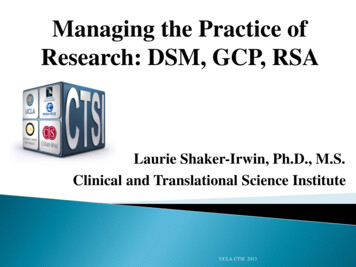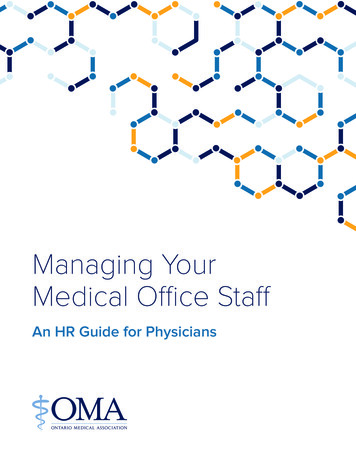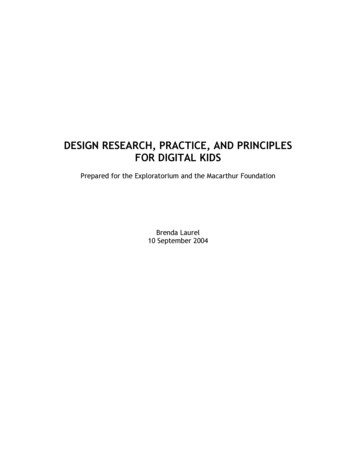
Transcription
Managing the Practice ofResearch: DSM, GCP, RSALaurie Shaker-Irwin, Ph.D., M.S.Clinical and Translational Science InstituteUCLA CTSI 2013
SafetyQualityIntegrityTrustUCLA CTSI 2013
CTSI Programs 310-794-CTSI‣Facilitation‣Post-Approval Research Oversight‣Clinical and Translational Research Centerand Laboratory‣Funding Opportunities‣Technology Resources and Cores‣Education and Training Programs‣Biomedical Informatics‣Study Design, Data Management andBiostatistics‣And MUCH MORE!!!UCLA CTSI 2013
‣Understand the protocol completely‣Recognize institutional polices and practicesthat apply to the protocol‣Organize and maintain regulatory documents‣Create protocol-specific research record(shadow chart, research file)‣Create protocol-specific source documents‣Practice good data managementUCLA CTSI 2013
Documentation of research activities should be completeand contemporaneous. Every interaction with the research subject, in person,telephone, e-mail, etc. should have a research note writtenin the research record detailing what transpired during theinteraction. All procedures, study agent accountability, adverse events,verbal discussions, laboratory results review, subjectcomplaints, etc. are also part of this documentation. Clinical research requires diligent and vigilantdocumentation. SOURCE DOCUMENTATIONUCLA CTSI 2013
Mustcapture all data required by theprotocol Assures protocol compliance because allprotocol events must be attributed to asource document specific to thevisit/event Substantiates study responsibility andaccountability; affixes ownership to dataUCLA CTSI 2013
IC/signed and dated HIPAA Authorization/signed and dated Study Inclusion/Exclusion Criteria Study Flow chart or checklist identifying allstudy events/procedures required by protocol Protocol-Specific Source Documents Final disposition of the subject and subjectstatus at study terminationUCLA CTSI 2013
Create Sections for: Adverse event reporting/tracking Study drug accountability Concomitant medication tracking Subject waiver forms, protocol deviations,notes to file, data queries, resolutions Clinical lab results/other tests/proceduresUCLA CTSI 2013
Study monitoring - performed to assess the qualityand completeness of the study documentation – it isusually performed by a clinical research associate(CRA), also known as a study monitor, who isaffiliated or hired by the study sponsor. Data and safety monitoring - performed to assess thesafety of the ongoing study – usually performed bymedical monitors, also known as data and safetymonitors/board members, who are usually contractedwith the sponsor to conduct the reviews.UCLA CTSI 2013
Data and safety monitoring is conducted concurrentlywith study monitoring. The two types of monitoring should be conducted onevery study involving risk to the research subject. Qualified and experienced individuals should performthe two distinct types of monitoring. Overall, such monitoring assures the safety of thesubjects and the overall integrity of the research study.UCLA CTSI 2013
The monitor/CRA reviews the data in the source document withthe data on the case report form (CRF) that is either in paper orelectronic format. These CRFs are used for data entry, management, and analysis,the results of which are submitted to the data and safetymonitoring board (DSMB) and to regulatory agencies, includingthe FDA. The higher the quality and the degree of completeness of the dataincreases the integrity of the study and allows for fastercompilation and more efficient reviews at regulatory agencies. This eventually leads to more rapid approval of efficaciousagents to treat patients.UCLA CTSI 2013
The main quality standard referenced for clinical researchis the International Conference on Harmonization GoodClinical Practices (GCPs). These GCPs outline the responsibilities of all thoseindividuals involved in the research process – theinvestigator, the IRB, and the sponsor. Sponsors may also have Standard Operating Procedures(SOPs) that must be followed as part of researchoperations and the sponsor may require that investigatorsadhere to many of these as well. The standards set the goals for assuring that the highestquality data is submitted as part of regulatory reviews.UCLA CTSI 2013
Accrual Rates and Recruitment Eligibility Criteria Informed Consents Accuracy of Data Completeness of Data Confidentiality of DataUCLA CTSI 2013Sources
Required by regulatory and sponsor agencies Systematic review of the data and adverse events atregular intervals to assess the ongoing safety of theparticipants and the conduct and integrity of theoverall study Data and Safety Monitoring methods are usuallydetailed in a specific Data and Safety MonitoringPlan (DSMP) The CTSI Regulatory program is available to helpwith development of DSMPs.UCLA CTSI 2013
Description of the collection, review andreporting mechanisms for adverse events andsafety information to the study monitors, IRB,FDA, sponsor (NIH, industry), and otherapplicable offices Description of any setpoints or guidance formodifying or stopping the study for efficacy,safety, quality assurance, or futility Description of the quality assurance effortsUCLA CTSI 2013
Deciding on the Monitoring Body Selection of Monitor(s) Content of Monitoring Frequency of Monitoring Decision-Making Criteria/Guidelines safety, efficacy, quality, futility Reporting MechanismsUCLA CTSI 2013
Protection and safety of study subjects Greater understanding of overall safety profile ofthe study Recognition of dose-related toxicities Appropriate modification of study protocols Improvements in study design and/or procedures Adherence to regulatory requirementsUCLA CTSI 2013
Adverse Event Any untoward or unfavorable medical occurrence in a human subject (physical or psychological harm) temporally associatedwith the subject’s participation in the research (whether or not related toparticipation in the research ).Incident – An undesirable and unintended, although not necessarilyunexpected, event or outcome involving any aspect of the research study.Deviations and violations – changes in procedures/research activities whichare different than the approved protocol and requirements of IRB approval(violation is usually more serious and involves safety issues)Unanticipated problem – Any of the above events or outcomes that isunexpected, related or possibly related to the study, and places subjects orothers at greater risk than previously known or recognizedUpdated safety information – DSMB reports, external SAE reports, etc.UCLA CTSI 2013
Recognize events Record all details of events Evaluate in context of study as torelationship and context Report events and their details as per policyto: data and safety monitors, IRB, campusdepartments, FDA, and sponsorsUCLA CTSI 2013
Inaccurate/inadequate or missing sourcedocuments (medical records) Delegation of event identification andreview to unqualified personnel Insufficient follow up of events todetermine resolution Events that are not reported to theIRB/other agencies in a timely fashionUCLA CTSI 2013
Maintain confidentiality until it is absolutelynecessary to disclose Notify all participants as quickly as possible anddocument notification Follow-up with hardcopy notice of changes to study,if applicable Ensure that all methods used in communicating studyinformation have been reviewed by the IRB.UCLA CTSI 2013
Serve as the voice of the research subject in thereview process Assist subjects with issues that may arise Review content of informed consent documentsand assist in monitoring of discussions Assist researchers in addressing ethically sensitivefeatures within a research project Assist with Data and Safety Monitoring Plans Assist researchers in complying with federal andstate regulations, UCLA policies and GCPsUCLA CTSI 2013
Comprehensive informed consent process Disclosing conflicts of interest Registration and results reporting of clinicalstudies (clinicaltrials.gov) and compliance withPublic Access Policy Supportive and caring personnel working withresearch patients Responsiveness to research subjects’ needs andconcerns about procedures, billing processes, andfollow up care.UCLA CTSI 2013
Knowing is not enough, we must apply.Willing is not enough, we must do.-- J.W. GoetheUCLA CTSI 2013
Laurie Shaker-Irwin, Ph.D., M.S.310-794-7504lshakeririwn@mednet.ucla.eduUCLA CTRC Clinical Research NetworkingSeminars:“Accomplishing Clinical Research BillingCompliance”Thursday, October 14th MacDonald ResearchLaboratories, 1st Floor Conference RoomUCLA CTSI 2013
Indian Supreme Court- Moratorium on new trialsPrevious lax oversightChanging rules for preventing injuries and deathRequiring licensing for ethics committeesTightening weak regulatory networkImpacts patients and their safetyImpacts NIH trial enrollmentHealth Ministry to have oversight instead of DrugController GeneralCurrent Status: Supreme Court to hear case on October 24thof 162 trials approved by the Ministry during themoratoriumUCLA CTSI 2013
Hypertension drug blockbuster ValsartanData tampering 1 billionKyoto Heart Study showed blocking of angiotensin andprevention of cardiovascular eventsAlleged image manipulations, concerns with statistics andconclusionsDiscrepancies with medical records, data set, overstatedadverse events in non-Valsartan group, missed events inValsartan groupIncorrect conclusionNovartis employees wrote published papersOutcome: Inadequate public support for clinical research;Possible outcome-focused version (similar to NIH)UCLA CTSI 2013
Data and safety monitoring is conducted concurrently with study monitoring. The two types of monitoring should be conducted on every study involving risk to the research subject. Qualified and experienced individuals should perform the two distinct types of monitoring. Overall, such monitoring assures the safety of the











